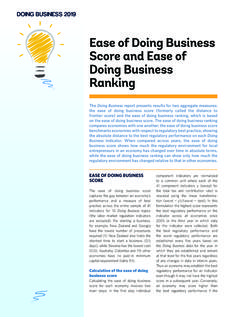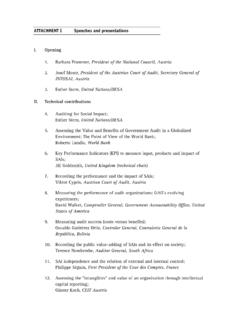Transcription of DETAILED DESCRIPTION OF EMPLOYMENT PROTECTION …
1 1 OECD EPL Database, update 2013 DETAILED DESCRIPTION OF EMPLOYMENT PROTECTION legislation , 2012-2013 OECD COUNTRIES TABLE OF CONTENTS AUSTRALIA .. 3 AUSTRIA .. 6 BELGIUM .. 8 CANADA .. 11 CHILE .. 14 CZECH REPUBLIC .. 17 DENMARK .. 20 ESTONIA .. 23 FINLAND .. 27 FRANCE .. 29 GERMANY .. 34 GREECE .. 37 HUNGARY .. 40 ICELAND .. 42 IRELAND .. 44 ISRAEL .. 47 ITALY .. 50 JAPAN .. 54 KOREA .. 56 LUXEMBOURG .. 59 MEXICO .. 62 NETHERLANDS .. 64 NEW 67 NORWAY .. 70 POLAND .. 73 PORTUGAL .. 76 SLOVAK REPUBLIC .. 82 SLOVENIA .. 85 SPAIN .. 88 SWEDEN .. 92 SWITZERLAND .. 96 TURKEY .. 98 UNITED KINGDOM .. 100 UNITED STATES .. 102 2 OECD EPL Database, update 2013 Australia 3 OECD EPL Database, update 2013 AUSTRALIA Items Regulations in force on 1 January 2013 1: Notification procedures in the case of individual dismissal of a worker with a regular contract An employer must not terminate an employee s EMPLOYMENT unless the employer has given the employee written notice of the day of the termination (which cannot be before the day the notice is given (Fair Work Act, (1) all references are to this act, except when differently specified).)
2 Section 123 limits the scope of the above provision for regular employees in the case of serious misconduct. The FW Act does not establish a general obligation to provide reasons before any dismissal. However, this obligation is implied since notification to the employee is one of the criteria to be considered by Fair Work Australia when assessing whether dismissal was harsh, unjust or unreasonable ( ) 2: Delay involved before notice can start Redundancy: written or oral notice with statement of reasons; Personal reasons: if disputed, fwa takes into account whether the employee was warned about unsatisfactory performance and given time to respond before dismissal. Calculation (for EPL indicators): 4 = average of redundancy (1 day) and personal reasons (6 days for warning + 1 day for notice) 3: Length of notice period at different tenure durations (a) All workers: 1w<1y, 2w<3y, 3w<5y, 4w>5y. These notice periods are increased by one week if employee is over 45 years old and has over 2 years continuous service.
3 Notice periods may be increased through collective agreements, particularly in cases of redundancy ( (3)). Calculation (for EPL indicators): 9 months tenure: 1week, 4 years tenure: 3 weeks, 20 years tenure: 4 weeks. 4: Severance pay at different tenure durations (a) Redundancy pay under the Fair Work Act as prescribed by s119(2): 0<1y; 4w<2y; 6w<3y; 7w<4y; 8w<5y; 10w<6y; 11w<7y; 13w<8y; 14w<9y; 16w<10y; 12w>10y. No obligation to pay redundancy pay for an employee whose period of continuous service with the employer<12 months or where the employer is a small business employer (<15 employees) ( ) 5: Definition of unfair dismissal (b) Whether a dismissal is unfair is decided by Fair Work Australia (which is the national workplace relations tribunal)(ss385, 390). An unfair dismissal occurs where an employee is dismissed, and i) the dismissal was harsh, unjust or unreasonable, and ii) the dismissal was not a case of genuine redundancy, and iii) the dismissal was not consistent with the Small Business Fair Dismissal code , where the employee was employed by a small business.
4 (A small business is a business that employs fewer than 15 employees.) ( ). This phrase harsh, unjust or unreasonable is not defined but factors taken into account in determining whether it applies are: whether there was a valid reason for the termination related to the capacity/conduct of the employee , whether the employee was notified of reason, whether the employee given opportunity to respond to reason related to capacity/conduct, whether warned of unsatisfactory performance if that s the ground of termination, degree to which employer s business affects procedures, degree to which absence of dedicated HR people impacts on employer s procedures. A person's dismissal is a genuine redundancy if i) the person's employer no longer required the person's job to be performed by anyone because of changes in the operational requirements of the employer's enterprise, and ii) the employer has complied with any obligation in a modern award or enterprise agreement that applied to the EMPLOYMENT to consult about the redundancy.
5 A person's redundancy is not a genuine redundancy if it would have been reasonable in all the circumstances for the person to be redeployed within the company or an associated entity of the company. This means that an employer cannot dismiss a worker on the basis of redundancy without first considering opportunities for redeployment. FW Act also contains a set of general protections against discriminatory or wrongful treatment which includes but is not limited to PROTECTION against dismissal on certain prohibited grounds. Prohibited grounds: marital status; pregnancy; maternity leave; family responsibilities; filing a complaint against the employer; temporary work injury or illness; race; colour; sex; sexual orientation; religion; political opinion; social origin; age; trade union membership and activities; disabilities; parental leave; adoption leave. 6: Length of trial period (c ) Employees are eligible to make an application for unfair dismissal if they have completed the minimum EMPLOYMENT period of: i) 1yr where the employer is a small business (fewer than 15 employees); or ii) 6 months where the employer is not a small business ( ) 7: Compensation following unfair dismissal (d) In addition to entitlements (that would have been) accrued until the end of notice period, FWA may award compensation for up to 26 week pay or half the amount of the high income threshold (which was $123,000 as at 1 July 2012 [it is indexed annually], so $61,650), whichever is lesser.
6 ( ) Australia 4 OECD EPL Database, update 2013 8: Reinstatement option for the employee following unfair dismissal (b) Reinstatement is the preferred remedy if FWA is satisfied an employee was unfairly dismissed then it may order the employee's reinstatement together with continuity of service and lost remuneration. (FWA web site; and see ss390 and 391). However, reinstatement is typically granted in no more than 20% of the cases in which the dismissal is found harsh, unjust or unreasonable by FWA. 9: Maximum time period after dismissal up to which an unfair dismissal claim can be made (e) 21 days, but FWA may allow further period if it is satisfied that there are exceptional circumstances ( (1) and (2), as amended by the Fair Work Amendment Act 2012). 10: Valid cases for use of standard fixed term contracts No restrictions in legislation 11: Maximum number of successive standard FTCs (initial contract plus renewals and/or prolongations) Estimated No legal limit specified; but risk that, upon continuous renewal, the courts will find that the primary purpose of the contract is to avoid termination laws.
7 12: Maximum cumulated duration of successive standard FTCs No limit specified. 13: Types of work for which temporary work agency (TWA) EMPLOYMENT is legal General 14: Are there restrictions on the number of renewals and/or prolongations of TWA assignments? (f) No. 15: Maximum cumulated duration of TWA assignments (f) No limit. 16: Does the set-up of a TWA require authorisation or reporting obligations? No 17: Do regulations ensure equal treatment of regular workers and agency workers at the user firm? Under FW Act, such workers must receive at least the minimum entitlements in the relevant modern award and National EMPLOYMENT Standards or where the agency has its own enterprise agreement relating to wages and working conditions, that agreement. 18: Definition of collective dismissal (b) Dismissal of 15 or more employees for reasons of an economic, technological, structural or similar nature, or for reasons including such reasons. (Fair Work Act, ).
8 [Specific rules on notification and consultation in case of collective dismissal do not apply in relation to certain employees under ] 19: Additional notification requirements in cases of collective dismissal (g) An employer is required to notify Centrelink in writing if the employer has decided to dismiss 15 or more employees for reasons of an economic, technological, structural or similar nature, or for reasons including such reasons. (s530(1)) The notice must be given as soon as practicable after the decision is made and before the employees are dismissed in accordance with the decision ( (3)). The employer also is obliged to notify or consult a registered employee association. ( (2)). 20: Additional delays involved in cases of collective dismissal (h) No specific delay in Act or Regulations, but must go through consultation steps with relevant unions, including measures to avert the terminations, or minimise the terminations, and measures (such as finding alternative EMPLOYMENT ) to mitigate the adverse effect of the termination(s) ( (3)).
9 Calculation (for EPL indicators): 2 days: 6 days for consultations 4 days for item 2 21: Other special costs to employers in case of collective dismissals (i) Type of negotiation required: Consultation on alternatives to redundancy and selection standards. Selection criteria: Law requires fair basis of employee selection. Severance pay: No special regulations for collective dismissal. Legend: d: days; w: weeks; m: months; y: years. For example 1m < 3y means 1 month of notice (or severance) pay is required when length of service is below 3 years . Notes: a) Three tenure durations (9 months, 4 years, 20 years). Case of a regular employee with tenure beyond any trial period, dismissed on personal grounds or economic redundancy, but without fault (where relevant, calculations of scores to compute OECD EPL indicators assume that the worker was 35 years old at the start of EMPLOYMENT ). Averages are taken where different situations apply blue collar and white collar; dismissals for personal reasons and for redundancy.
10 B) Based also on case law, if court practice tends to be more (or less) restrictive than what specified in legislation . c) Initial period within which regular contracts are not fully covered by EMPLOYMENT PROTECTION provisions and unfair dismissal claims cannot usually be made. d) Typical compensation at 20 years of tenure, including back pay and other compensation ( for future lost earnings in lieu of reinstatement or psychological injury), but excluding ordinary severance pay and pay in lieu of notice. Where relevant, calculations of scores to compute OECD EPL Australia 5 OECD EPL Database, update 2013 indicators assume that the worker was 35 years old at the start of EMPLOYMENT and that a court case takes 6 months on average. DESCRIPTION based also on case law. e) Maximum time period after dismissal up to which an unfair dismissal claim can be made. f) DESCRIPTION based on both regulations on number and duration of the contract(s) between the temporary work agency and the employee and regulations on the number and duration of the assignment(s) with the same user firm.















